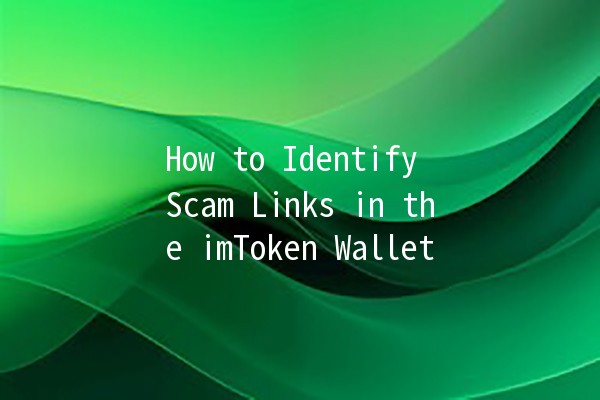In today's digital landscape, the rise of cryptocurrency has brought with it new opportunities and risks. One aspect that users of cryptocurrency wallets, such as imToken, must be vigilant about is the identification of scam links. These deceptive links can lead to phishing sites, resulting in financial loss and compromised personal information. This article will explore how to recognize these fraudulent links, offering practical advice and effective techniques to enhance your security while using the imToken wallet.
Phishing is a technique used by cybercriminals to imitate legitimate sources to lure users into revealing sensitive information, such as private keys, passwords, or financial data. Scam links are often shared through emails, messages, or social media, posing as promotions or official communications.
In assessing the legitimacy of a link, several factors can raise red flags:

To bolster your defenses against scam links while using the imToken wallet, consider implementing these five productivityenhancing techniques:
Explanation: Before clicking on any link, take a moment to analyze the URL carefully.
Application: Use tools such as VirusTotal to check URLs for malware and phishing. Always crossverify the link format against legitimate ones from the official imToken website.
Explanation: Scammers often disguise their malicious links using URL shorteners.
Application: Use link expanding services like CheckShortURL or Unshorten.link to reveal the full destination of a shortened URL. This way, you can verify the legitimacy of the website before clicking.
Explanation: Several browser extensions can automatically warn you about suspicious links.
Application: Install tools such as Web of Trust (WOT) or McAfee SiteAdvisor, which provide safety ratings for websites in realtime, enabling you to make informed decisions about which links to click.
Explanation: Often, scam messages replicate promotions from reputable companies to steal personal information.
Application: Always verify offers by going directly to the official website or app of the service in question. If you receive a link claiming to provide an imToken promotion, open your app directly and check the updates or announcements within it.
Explanation: Reporting can help decrease the prevalence of scams and protect others.
Application: If you encounter a suspicious link or a phishing attempt, report it to the relevant authorities or the official support channels of imToken. You can help promote a safer online community by taking this proactive approach.
Scam links often exhibit certain characteristics: irregular URL structures, lack of HTTPS, vague or misleading text, and urgency. Always perform a thorough check for any discrepancies.
Phishing emails generally contain spelling or grammatical errors, generic greetings, and a lack of personalization. Moreover, they often encourage you to follow links instead of safely logging into your account.
Using public WiFi can expose you to various security risks, including phishing attacks and maninthemiddle attacks. If you must use public WiFi, ensure you use a VPN to add a layer of security.
Phishing is particularly prevalent in the cryptocurrency domain due to the irreversible nature of transactions. Users should remain vigilant and adopt preventive measures to avoid falling victim to scams.
While antivirus software enhances security, it should not be solely relied upon. Users must exercise caution and research any links before clicking, as social engineering plays a significant role in successful phishing attempts.
If you've clicked on a suspected scam link, change your passwords immediately, and monitor your accounts for unauthorized transactions. Additionally, run a malware scan to check for any infections.
To ensure your safety and security while navigating the world of cryptocurrency and using the imToken wallet, adopting proactive measures is essential. Regularly updating your wallet app, enabling twofactor authentication, and being conscious of your digital interactions will further safeguard your assets from potential threats.
The combination of awareness, good practices, and the use of tools to recognize and avoid scam links will significantly enhance your security while using the imToken wallet. Siempre stay informed about the latest scams and cultivate a habit of doublechecking links before engaging with them. By doing so, you can enjoy a safer cryptocurrency experience and minimize the risks associated with phishing and scams.